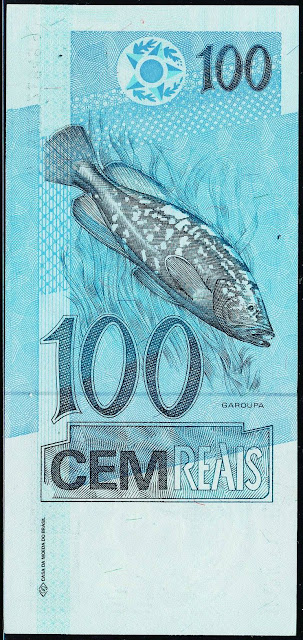Brazil Banknotes 100 Reais banknote 2005 Grouper
Central Bank of Brazil - Banco Central do Brasil
Obverse: The Effigy of the symbolic sculpture of the Republic of Brazil (Portuguese: Efígie da República) is used as a national personification, both in Brazil and in Portugal, symbolizing the Republic. Inscription: "God Be Praised" (Portuguese: DEUS SEJA LOUVADO).
Reverse: Picture of a Dusky Grouper (Epinephelus marginatus), fish of the family Serranidae, and it is one of the most known found in the Brazilian coast.
Watermark: Grouper and electrotype 100.
See-through register: Coat of arms of Brazil.
Size: 140 x 65 mm.
Printer: Casa da Moeda do Brasil (CMB).
Signatures: Ministério da Fazenda: Guido Mantega.
Presidente do Banco Central do Brasil: Henrique de Campos Meirelles.
Brazilian Currency Banknotes - Brazil Paper Money
July Monetary Reform: 1 Real = 2750 Cruzeiros Reais
1994-2012 "Real" Issue
Dusky Grouper
The Dusky Grouper (Epinephelus marginatus, formerly Epinephelus gigas), or Merou is the best known grouper of the Mediterranean Sea and North Africa coast. It is said to have the best taste of all Mediterranean fishes.
The Dusky Grouper has a big body with a big mouth. One long dorsal fin and a rounded tail. Its color varies from brown to green depending on the season and the age. It is green during its juvenile phase. The adult is upper brown with yellow spots and lower yellow. On the Operculum there are three spines.
Habitat
The dusky grouper is a solitary fish. It likes to live alone in rocks, at depths from the coast to 300 meters, but it's rare to find it below 60 meters. It has a barometric distribution, where the younger specimens are found near the coast and the older ones at the depths.
It normally has one cave considered as home and several other caves as temporary refuges. Its home has a minimum of two exits, and a size slightly bigger than the grouper, so no bigger animal can enter in. In case of biting attack or other force to extract it, the grouper opens its mouth, and the operculum spines wedge it inside the cave.
It can be found in the Mediterranean, the African west coast (Azores, Canary Islands) and the coast of Brazil. It is rare in the waters of the western Indian ocean, Uruguay, Argentina, north of France and the British Isles.
Reproduction
It is a protogynous hermaphrodite, i.e. the young are predominantly female but transform into males as they grow larger. Reproduction normally takes place between the summer months.
Nutrition
It feeds mainly on other fish, crabs and octopus. It is very greedy and one of the major predators in the Mediterranean sea.
Fishing
In some countries the dusky grouper is considered a delicacy. Referring to its preference among restaurant guests, the Spanish say 'De la mar el mero y de la tierra el carnero' (From the sea the dusky grouper, from the land the lamb).
Due to overfishing, it is now considered an endangered species.
Size
It normally grows to lengths of between 50 and 100 cm, and between 3 to 10 kg. But it is not rare to find exemplars of more than 40 kg. It can grow up to 150 centimeters in length and 60 kilograms in weight.

